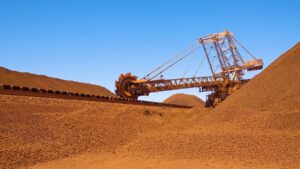Tim Treadgold: Mt Gibson floats higher as the floodwaters recede

Pic: Bloomberg Creative / Bloomberg Creative Photos via Getty Images
As an example of Newton’s third law of motion, the one that says every action produces an opposite reaction, investors need look no further than Mt Gibson Iron where the falling water level in the flooded Koolan Island pit is being reflected in the company’s rising share price.
In hindsight, the share-price rise as the water level has been falling in Australia’s highest-grade iron ore mine was predictable, with the only surprise being that more investors did not take advantage of a situation that had been obvious for some time.
But, for anyone who missed the revival of Mt Gibson, a WA-focussed iron ore miner which was heavily sold off after the flooding of its mine in 2015, there is still a chance to jump aboard because the stock could have a bit further to rise.
Macquarie Bank reckons that Mt Gibson is heading for 65c, but it could go as far as 75c depending on a combination of factors such as the iron ore price (which remains supportive of the higher share price) and the US dollar exchange rate.
A reason for feeling optimistic about the 75c price, which is 17c (29%) above latest sales at 58c, is that as a major de-watering campaign lowers the water level in the Koolan Island pit, a restart on full-scale mining gets closer. That’s followed by first iron ore sales in less than two months, which is in turn followed by the kaching of cash hitting the company’s bank account.
Not everyone believed that the mine would recover from the flooding of its main pit on Koolan Island off the Kimberley Coast after a seawall gave way and the Indian Ocean rushed in.
Fortunately for Mt Gibson it was fully insured for such an event, as well as having cover for loss of production with insurers meeting the company’s claims which, when married with ongoing cash flow, boosted the cash holdings of Mt Gibson to a handsome $457 million at last June 30.
Back then, when the company’s share price was around 40c, cash represented the lion’s share of the company value on the stock market which was around $480 million.
Today, as interest grows in Mt Gibson’s resurrection of the Koolan Island mine and its rich iron ore that grades 65.5% iron (3.5% above the widely quoted benchmark which is for 62% iron ore) the company’s market capitalisation has risen to $648 million, an increase no doubt, but a value which is still largely represented by cash and not much for the mine itself.
“Mt Gibson offers unique exposure to high-grade iron ore,” Macquarie Bank said in its latest report on the company. “On restart of mining Koolan Island will have the highest-grade direct shipping hematite ore in Australia.”
- Subscribe to our daily newsletter
- Bookmark this link for small cap news
- Join our small cap Facebook group
- Follow us on Facebook or Twitter
There is, however, an issue with Koolan Island that’s worth remembering. It’s been an operating mine, on-and-off, since the 1950s. First as a source of ore for BHP’s steelworks, and later as a supplier to China, a long life which means it is getting close to running out of ore.
Reserves are currently estimated around 21 million tonnes, enough for around five years of production, which is short for any mine, though in the case of Koolan Island which has minimal transport costs (the pit is next to the ship-loader) it should still be handsomely profitable.
The wash-up
Macquarie reckons that Mt Gibson is on track to report a modest profit in the current financial year of around $23 million, largely from a second mine on the mainland, with a loss next year as Koolan Island kicks into production, followed by a hefty profit of $47.3 million in 2021 which should support a 1c increase in the annual dividend to 4c a share.
As an investment, Mt Gibson is largely a cash-backed asset with an option on an iron ore cash cow that should be good for a few years with management undoubtedly working on a plan for life after Koolan Island.
In a way, it’s the life after the island which makes Mt Gibson an interesting company because it can be seen as a business with a fistful of dollars looking for a deal, which might, or might not, be in iron ore.
UNLOCK INSIGHTS
Discover the untold stories of emerging ASX stocks.
Daily news and expert analysis, it's free to subscribe.
By proceeding, you confirm you understand that we handle personal information in accordance with our Privacy Policy.








